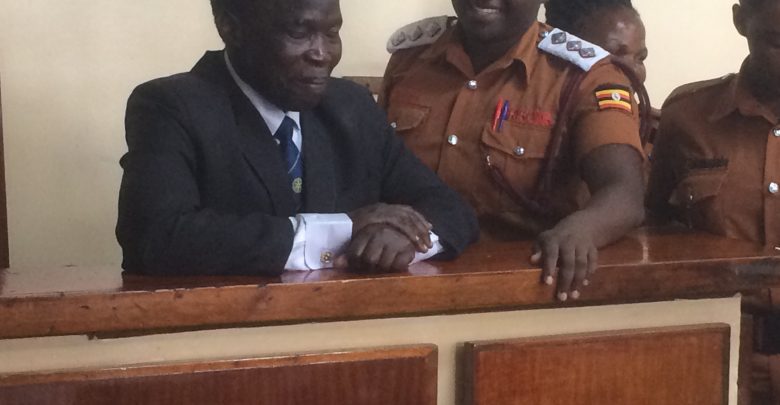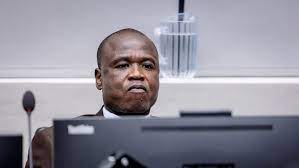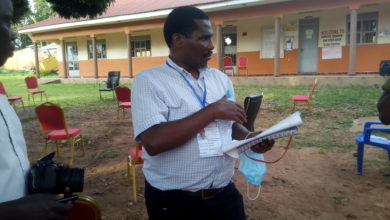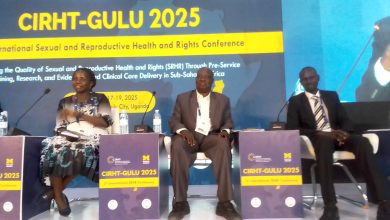
Global Politics
UGANDA: JUSTICE MUBIRU SUMMING UP SUMMON BEFORE I.C.D COURT
International Crimes Division Judges to passed judgement whether to convict of set former LRA Thomas Kwoyelo free
Out of those 78 my instructions to you as Assessors will be limited to 18 counts and the 18 counts are the offences in violation of the Geneva Conventions.
There are five different types of offences, five of them are the offences of murder, and you will find them in counts 2, 16, 21, 51 and 75.
There are also two counts of Pillaging; these are counts 13 and 17.
There are three counts of Cruel Treatment; these are counts 43, 48 and 72.
GULU CITY- TUESDAY, 23, JULY, 2024.
(By Okumu Livingstone Langol, the Guardians News, UK)
There are two counts of Violence to Life; these are counts 87 and 92.
Then there are six counts of Outrages against Personal Dignity; these are counts 44, 49, 73, 82, 86 and 91.
Now for convenience, I will be addressing these counts per type of offence together. I have combined for example all counts of murder, all counts of pillaging, all counts of cruel treatment and violence to life and so on.
My address to you will consider one type of offence combining all these counts because the principles applicable to them are the same to avoid repetition.
I will start with the offence of murder as a war crime. Geneva Conventions are about methods and practices during war. So I will be referring to them as war crimes.
Therefore, murder as a war crime requires the proof of the following; it must be proved that there was an act or omission that resulted in the death of a human being. That act or omission should have occurred or been committed willfully, the person who did it must have been acting willfully. Willfully means they understand what they are doing, it is not an accident.
That death must have a connection to an armed conflict that is not of an international character. There should be a connection between the death and that type of conflict.
The fifth requirement is that the victim was not taking any active participation in those hostilities.
Lastly, there should be evidence to show that the accused person participated in committing those acts that resulted in death.
So in those five counts of murder, in count 2, you will find evidence of two witnesses that may be relevant PW5 and PW6; one is a brother, the other is the wife of the deceased. Both claim to have seen his body.
In count 16, you will look at the evidence of PW5, PW14, and PW15 these three witnesses claim to have seen the bodies of the persons named in that count. PW53 that is the investigating officer also said he was shown some of the graves of those people.
In count 21; you will be considering the evidence of PW19 the daughter of the deceased, PW53 the investigating officer,PW26 who is a daughter-in- law, PW18 is a wife of one of the victims and claimed to be an eye witness, thenPW19 one of the survivors.
For count 51 you will find evidence of persons who claim to have seen these bodies; the medical officer PW21, the camp leader PW32, PW33 was related to one of the victims as a daughter-in-law, PW35 testified about the killing of her child, while strapped on her back.
In count 75, you will consider the evidence of PW45, PW46; these claim to have been at the scene, PW43 as well and PW44.
So for each count, you will have to determine whether there is any doubt that any of the named victims are dead based on those witnesses. Do you believe these people named in each of the five counts is dead?
Second you are to determine whether their deaths were caused by another person willfully, intentionally, they were not accidental. You will be considering more or less, the same witnesses for each count. They have aspects of the type of wounds they saw, some of them claim to have been present during the actual event. So from what they told court, do you know what caused the death of each of these deceased persons? If you know from their testimony, was that cause lawful? If it is not accidental, it is not a suicide, it is not authorized by law, it is presumed unlawful.
When you come to the third element whether these events occurred during an armed conflict, you will consider PW1 about the historical evolution of this conflict, when did it start, how long it lasted. He did some research and presented a report about the conflict.
PW2 was recruited into the force and gave a narrative of his experience while a combatant of the LRA. If you believe him, you will find the geographical area that was covered, the number and the intensity of these attacks wherever they occurred to rule out the possibility that they were isolated occurrences. There must be a sustained conflict over a period of time, that is what you are looking out for. It is not a mere isolated incident that happened there should be a sustained conflict.
Other witnesses to help you to make that decision would be PW3, PW25, PW31, PW48 and PW52, these were abductees; at one point or the other were abducted and they explained places they were taken to and the incidents that happened during the period of their abduction.
So if you find the conflict took a considerable period of time, a reasonably large area geographically and involved many incidents of a similar nature that involved arms or the use of guns and other types of ammunition. Then you will be satisfied that one element of the conflict is proved.
The second element, the forces or entities that are involved in the conflict should be structured, the type of command structure/hierarchy. There are two sides to the conflict there is the UPDF and the LRA. We heard testimony from PW1, PW2, PW3, PW25, PW31, PW48 and PW52 giving an insight into the structure of the LRA in terms of hierarchical leadership.
Here you may also consider the defence of the accused about this structure then decide whether they had such a command structure.
The other aspect of this element is that the conflict did not involve any other state directly. There was evidence from the same witnesses that I have already highlighted, that the conflict on occasions spilled over into Sudan by then.
There was evidence that some training and supply of arms and other logistics came from the Sudan.
The conflict becomes internationalized if there is direct participation of another state by controlling the force that is at war with another state.
If you are convinced LRA was under direct control and direction of Sudan then it was internationalized, if they stopped at mere supply of arms, logistics and training that is not direct involvement.
The fourth element is the connection between those vertical deaths and that conflict. The evidence should show that the person was killed, in order to achieve the purpose connected with the armed conflict or under the guise, taking advantage of it to commit the offence.
Here we have one victim where it was argued that it was not proved that his death was connected in the armed conflict, that is the victim in count 2- Obwoya.
You consider the behavior of the assailants, were they mere robbers looking for money from him or was his killing in any way connected to the conflict.
The rest again, you will consider their circumstances and see if whether or not their deaths were in any way connected to the conflict.
The fifth element is the victim should not be taking active participation in the conflict. The only mode of participation suggested in the trial is gathering and transmitting military intelligence or information related to military intelligence in respect of the victim in count 2- Obwoya.
If you find that this person’s death is not connected to the conflict or that he was not a protected civilian, then it seizes to be a war crime, it becomes an ordinary crime of murder, hence that is where you consider the alternative offence of murder.But if you find that his death was connected to the conflict and that he was a protected civilian, someone not involved in the conflict at all,then it remains an offence of murder as a war crime. That is the distinction. So in absence of the connection, you will consider an alternative.
For the rest, the evidence seems to suggest but you have to examine it closely, that they were civilians going about their ordinary business, some living in camps, others living in their homes and there is nothing to suggest they were active participants in the conflict but you have to examine it closely to arrive at that conclusion.
Lastly about murders, consider the participation of the accused in these multiple deaths if they occurred.
You start by reviewing his defence, his alibi, he was never at any of these scenes, he was an escort to Dr. Ocii, he was in the Sick Bay not in the convoy, he had no reason to kill his own relatives. These are the major positions he took in his defence.
There are four ways in which he can be incriminated, the first one is known as Joint Criminal Enterprise-1 (JCE-1), it covers the direct perpetrators, those at the scene and committing the acts themselves, it also covers those who assist them in committing the offence even though they are not at the scene .Many times they are, we call them co-perpetrators. They aid, they abate, they procure all those methods of helping another commit a crime. They share the same intention.
Here that type of participation is alleged in count 2, count 21, count 51 and count 75. He is either at the scene or participated in the planning or execution of the killings/the action. That is the allegation in those counts.
So in those counts, evidence of visual identification is critical, you have to examine it and see whether it disproves his alibi.
The second method in which he can be held culpable is calledJoint Criminal Enterprise-2 (JCE-2). It covers all members of a criminal organization that is well structured and has a hierarchical leadership. It doesnot matter what their role is; whether you are a cook, a driver, whatever role you are playing in that organization, provided you know what the organization is doing and you render that service with that knowledge. So here, if you are satisfied that there is a systematic way of committing these offences by an organization which has leadership and command, anyone who is a member of that organization is criminally responsible for whatever it does.
What you have to examine is at the time these offences were committed,did the LRA have such a structure? If it did, then whatever role the accused could have played provided he knew what it is all about and he offered to play that role with that knowledge he is held criminally responsible for the offences it commits.
But if it had no structure or he was not aware what they were doing, then the fact that he is at the Sick Bay and away from the scene exonerates him. But if he was aware and knew what they were doing and was playing a role in an organization of that nature that has that structure, it doesnot matter that he is away and playing a different role treating those who are injured and so on and so forth, it doesn’t matter, that is part of the organization and part of what they are doing.
Third mode of JCE-3 does not apply here, so in case you are familiar with it, it doesn’t arise, it is about offences committed which are not part of the original plan.
The last one, is command responsibility.
Command is about indirect orders or direct orders by a superior to a subordinate.It can apply to military type of structures as well as civil ones. It is attributed to someone who fails to prevent or to punish those who commit these types of crime.
In count 21, there was evidence from PW19 that it was the accused giving directions which were then implemented by his subordinates.
In count 51, there was evidence of PW31 who said although he was not at Pagakin the campduring the attack, he remained behind having given instructions and when the abductees were brought to where they were waiting, he received an order from Otti to kill all abductees, he in turn gave a similar order to other youths who cut sticks and began beating them.
If you believe that evidence, then you can consider command responsibility as well for those two counts.
That covers the first five counts. For the rest of the counts, it will be shorter because I have demonstrated to you the analysis you will be dealing with the same witnesses more or less but from different perspectives.But before I can do that I think we need to take a break.





